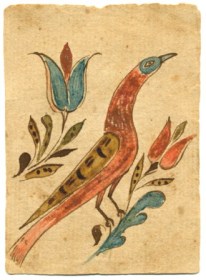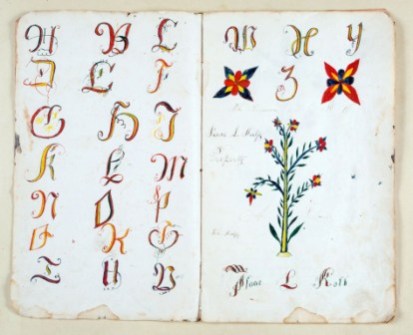Our Immigrant Heritage: Kolb/Kulp
Written by Forrest Moyer on March 22, 2017

This is the first in a series of posts highlighting families descended from 18th-century Mennonite immigrants to eastern Pennsylvania, in connection with a new exhibit opening April 1, 2017 at the Mennonite Heritage Center, entitled Opportunity & Conscience: Mennonite Immigration to Pennsylvania.
The exhibit will commemorate the 300th anniversary of the arrival in 1717 of the first large group of Mennonite settlers to Pennsylvania, and will include recent immigrant stories as well. Look for photos of the exhibit installation next week here on the blog.
Five brothers from Wolfsheim
The Mennonite Kolb family (often spelled Kulp) is primarily descended from five brothers who came to Pennsylvania from the village of Wolfsheim, Germany in 1707-09 and 1717. Their older brother Peter Kolb remained in Germany, serving as bishop in the Mennonite congregation at Mannheim. Their grandfather Peter Schumacher (a Quaker convert) and aunt Veronica Schumacher Van Bebber were already here in Pennsylvania.
Three of the brothers–Martin, John, and Jacob–came in 1707. Their brother Henry came in 1709, and youngest brother Dielman followed with the larger immigrant group of 1717.
Henry had been ordained in Europe (by his brother Peter) to serve as bishop for the Mennonite community at Germantown and Skippack. He shared that role with Jacob Godshalk, who had begun functioning as bishop prior to Henry’s arrival. Initially there was conflict in the congregation over who was the proper bishop; both sides wrote back to Europe with complaints. Peace was restored when European leaders suggested that Henry Kolb confirm the ministry of Jacob Godshalk and work together. Henry Kolb died young, in his fifties, while co-bishop Godshalk long outlived him. In the oral tradition, Henry’s role as bishop was forgotten, and Jacob Godshalk alone was remembered as the first Mennonite bishop in America. More recently, letters were uncovered in the Mennonite Archives at Amsterdam that reveal Henry’s role. See Documents of Brotherly Love, Vol. II by James W. Lowry (Millersburg, OH: Ohio Amish Library, 2015), pp. 862-873, available in the MHC library.
Martin Kolb served as a preacher at Germantown and Skippack, and brother Jacob was ordained a deacon following the family’s move to Skippack circa 1709. Both Martin and Jacob married daughters of Isaac Van Sintern, the Mennonite deacon at Germantown.
Brother Dielman Kolb became a minister several years later, serving the Salford Mennonite community. His substantial stone house on Kinsey Road, built circa 1740, was beautifully restored in the late 20th century.
Brother John (Johannes) Kolb did not remain Mennonite or in Pennsylvania. He moved to South Carolina around 1737, settling on the banks of the Great Pee Dee River in Darlington County. Today there is a significant archaeological dig at the site of his homestead.
Andreas Kolb
One of Martin Kolb’s grandsons, Andreas Kolb (Andrew Kulp) (1749-1811), was a schoolteacher in the German-language Mennonite schools that dotted eastern Pennsylvania before the advent of public education. Andreas became quite skilled as a creator of fraktur (i.e., decorated manuscripts) for students, expanding on the tradition of his own teacher Christopher Dock at Skippack, and Kolb’s friend and colleague John Adam Eyer, who taught in Bucks County Mennonite schools. Andreas was unmarried and had the freedom to move hither and yon teaching and creating fraktur from 1785 to 1808, in places as widespread as Vincent, Franconia, Upper Saucon and Springfield.
At least 70 pieces of fraktur survive from the pen of Andreas Kolb. He was prolific and his work was treasured and preserved in family Bibles, desks and chests over centuries. His designs are characterized by vibrant birds and flowers, bold borders, and a few unusual motifs such as cedar trees and the whimsical (sometimes practical) use of a heart symbol as a stand-in for the word “Hertz (heart)”.
The Vorschrift (writing model) below, made by Andreas Kolb for an unknown student in December 1786, was recently donated to the MHC by a collector living in and preserving a colonial-era Kolb family home. The first verse of the hymn text “Du Sonne der Gerechtigkeit, Herr Jesu Christ mein Leben…” translates as: “Thou Sun of Righteousness, Lord Jesus Christ, my life; let thy reflection, at all times, give light and clearness to me. Illumine me, quite inwardly, thou bright sun of grace, Lord Jesus, joy of grace.”
Kulp’s of Bucks County
Children of immigrants Henry and Jacob Kolb moved to Bucks County in the mid-1700s, where the family chose to spell their name “Kulp” when writing in English.
The Bucks County Kulp’s also created fraktur. David Kulp (1777-1834) of Bedminster Township was a schoolmaster who studied under John Adam Eyer. David created fraktur with a symmetry and finesse that surpassed his predecessors.
In the mid-to-late 19th century, Isaac L. Kulp (1849-1915) of Plumstead Township continued to make fraktur, decades after the general practice had ceased with the coming of public education. Isaac made bookplates for friends and family, and drew in his own practice/copy book, which is now in the MHC collection. His work was less refined, but continued the old tradition. From these and other late 19th century pieces, it appears the Deep Run Mennonites continued teaching fraktur, probably in a German Sunday or Saturday school.
Kolb’s of Vincent, Chester County
In Chester County, a Kolb family became prominent in 20th century church leadership. Their ancestor John Kolb (1795-1871), a great-grandson of immigrant Martin, had moved west from Skippack to East Vincent Township in 1828. His son Jonathan, born 1825, became a deacon in the Vincent Mennonite congregation at age 50 and served 22 years until his death in 1897.
Jonathan and Elizabeth Funk Kolb had three children–John, Jacob, and Sarah (who died as a child). This is a photo of brothers John and Jacob Kolb, circa 1858.
The brothers were aged 25 and 23 when their father was called to provide care and oversight for the Vincent congregation. John had a two-year-old son, and Jacob was just recently married. Likely they raised their families with an understanding and appreciation for church leadership, but neither could have predicted that a century later, for forty years from 1948-1988, all ordained leaders in the Vincent congregation would be sons and grandsons (or grandsons-in-law) of John and Jacob Kolb. Additionally, grandsons pastored the congregations at Pottstown, Norristown, Providence and Morris. In 1990, the first woman to be ordained by Franconia Mennonite Conference was Jacob’s great-granddaughter, Martha Kolb-Wyckoff.
Descendants continue to provide significant lay and ordained leadership today, in the Mennonite Church and beyond.

Mostly ordained brethren talking together at a Vincent church picnic, early 1960s. Left to right: Jacob Kolb (minister at Vincent), John Guntz Sr., Amos Kolb (with back to camera, bishop at Vincent), John Kolb, John Guntz Jr., J. C. Clemens (visiting preacher), Charles Kolb (deacon at Vincent).
Sources on the Kolb/Kulp family:
Amsler, Cory M., ed. Bucks County Fraktur. Doylestown, PA: Bucks County Historical Society. 2001. See articles on David Kulp (pp. 151-165, 270-274) and Isaac L. Kulp (pp. 318-319).
Cassel, Daniel K. A genealogical history of the Kolb, Kulp or Culp family and its branches in America…. Norristown, PA: Morgan R. Willis. 1895. Available online at https://archive.org/details/agenealogicalhis00cass.
Hershey, Mary Jane Lederach. Andreas Kolb (1749-1811), Mennonite schoolmaster and fraktur artist. Reprinted from the Mennonite Quarterly Review LXI (April 1987), 121-201.
Johannes Kolb Archaeological Site. Web. 31 Oct 2016. https://38da75.com/about/.
Kolb, Doris. History of the John F. and Amanda (Zollers) Kolb family and their descendants. Self-published. 2012.
Kolb, J. W. The decendents of Jacob F. Kolb and Emma (Buckwalter) Kolb. Self-published. 1984.
Kolb-Kulp-Culp Family Association. Web. 31 Oct 2016. http://kolb-kulp-culp.org/home.
Ruth, John L. Maintaining the right fellowship: a narrative account of life in the oldest Mennonite community in North America. Scottdale, PA: Herald Press. 1984.
Wenger, John C. and Nanne van der Zijpp. “Kolb family.” Global Anabaptist Mennonite Encyclopedia Online. 1955. Web. 28 Oct 2016. http://gameo.org/index.php?title=Kolb_family&oldid=119592.
Wenger, John C. History of the Mennonites of the Franconia Conference. Telford, PA: Franconia Mennonite Historical Society. 1937.












